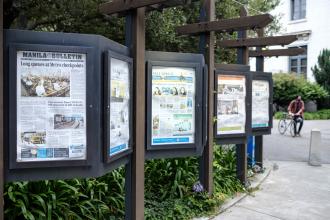There’s a spot in Berkeley where time has stopped and a five-month lockdown never happened. The front pages of newspapers from around the globe report on a relatively new virus called COVID-19 and how different nations are tackling it. Wild, irresponsible assertions about the ingestion of bleach as a cure, and grim statistics like 1,000 Americans dying every day would, at that point, have been greeted with disbelief.
“Coronavirus Virus Rescue Plan” the front page of the New Zealand Herald trumpets optimistically, suggesting that by simply implementing some correctional measures, an encroaching global pandemic might be nipped in the bud.
“157 nations in virus net, 6,485 killed” reads the lead headline of the Gulf News, an English-language newspaper published from Dubai.
Other newspapers hint at a more ominous future: “Quarantine measures expand amid virus fear” writes the Daily Sahah, a Turkish pro-government daily. And The Guardian predicts “Virus ‘may last a year and put 8m in NHS hospitals.’”
Mounted in glass-fronted display cases outside the Free Speech Movement Cafe at the south entrance to Moffitt Library on the UC Berkeley campus, all the newspapers are dated March 15 or 16, the “before” time — just ahead of Berkeley and the Bay Area going into quarantine.
It’s almost like the day the world stood still,” said David Tjen, who has been taking walks on the campus with his wife since the pandemic started and noticed that the newspapers hadn’t been switched out.
Berkeley City Councilmember Rigel Robinson described the display as being “like amber.” “It’s the tiniest little thing, but I find it so profoundly unsettling, he posted to Twitter on July 28.
Glenn Gillespie, reference and information specialist for the social sciences division of the UC Berkeley Libraries, calls it a time capsule.
“It’s sad but poignant at the same time,” he said when asked about the newspapers, pointing to stories that speak of ways the pandemic could have been addressed more effectively early on.
Gillespie said the original idea for the newspaper display was initiated around 15 years ago by Mike Rancer, the library’s then chief administrative officer. The concept was to highlight diversity and open thinking — to show what the world is thinking about a particular event from many different perspectives, “not just the CNN view of world news.”
In correspondence sourced by Elizabeth Dupuis, senior associate university librarian, Rancer describes his thinking behind the project:
I selected the original rotation of papers based on an attempt to represent each continent with quality papers. We mostly went with English and a handful of French and Spanish, figuring people could probably divine the headlines in those languages. When we went to the current 16 paper display, we found there weren’t much more than that number available each day if we wanted to keep to the same standards. So now we pretty much run the same papers each day. Some variation in a couple of the slots but mostly the same 16. The one ironclad principle we follow is that if we run an Arab paper, we run an Israeli paper the same day, and vice versa.
Gillespie has only been on campus three times since March 16, but he used to be the tour coordinator for the two libraries and he would always end his tours at the newspaper display. “It was a natural progression,” he said.
The responsibility for changing out the newspapers fell to the Moffitt Copy Center, which is less than 50 feet away from the stands, but has not had staff on-site due to COVID-19 since the shelter-in-place order went into effect. Employees would get digital files of the newspapers’ front pages for free from Newseum.org, the website of the Washington DC museum that closed last year, then print them out, Gillespie said. The Newseum had a similar display at its museum.
“The front pages were switched out every morning by 9 o’clock — except when there was heavy rain,” Gillespie said.
One display case became Gillespie’s own domain after he initiated the idea of a “flashback news” front page. Every week on Thursday he used to put up a front page with a headline relating to historic news that was reported in the last 100 years during the same week — the beginning of World War One, Elvis Presley dying or the first man landing on the moon, for example.
Meanwhile, all the university libraries are trying to figure out how to safely reopen. Between them, they employ around 1,000 people, 600 of them student workers, according to Gillespie, who said there is a “five-chapter” plan for reopening.
“We are currently in chapter one, with only about 20 library staff on campus who are opening mail, checking in returned books and so on. We’d like to be able to provide curbside pickup eventually. But it’s going to be a long time. It’s going to be baby steps”
Tracey Taylor is co-founder of Berkeleyside and co-founder and editorial director of Cityside. Email: tracey@citysidejournalism.org.
